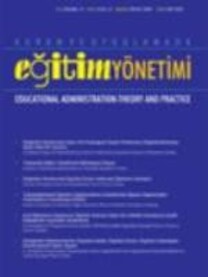Öğretmen Rotasyon (Zorunlu Yer Değiştirme) Ölçeği'nin Geliştirilmesi
Teacher Rotation (Compulsory Relocation) Scale Development
___
- Adomi, E. E. (2006). Job rotation in Nigerian University Libraries. Library Review, 55(1), 66-74.
- Arabacı, İ. B. ve Sağlam, H. (2012). Zorunlu rotasyon uygulamaları konusunda okul yöneticilerinin görüşleri. Mustafa Kemal Üniversitesi Sosyal Bilimler Enstitüsü Dergisi, 9(20), 529-547.
- Aydın, M. (2014). Çağdaş eğitim denetimi. Ankara: Gazi.
- Balcı, A. (2005). Sosyal bilimlerde araştırma: Yöntem, teknik ve ilkeler (5. baskı). Ankara: Pegem A.
- Bentler, P. M. (1990). Comparative fit indexes in structural models. Psychological Bulletin, (107), 238-246.
- Büyüköztürk, Ş. (2007). Sosyal bilimler için veri analizi el kitabı. Ankara: Pegem A.
- Campion, M. A., Cheraskin, L., & Stevens, M. J. (1994). Career-related antecedents and outcomes of job rotation. The Academy of Management Journal, 37(6), 1518-1542.
- Cavins, J., & Pinto, M. (2005). The impact of HRM on organizational performance: An examination of contingency theory. Human Resource Management Review, (30), 357-369.
- Chingos, M. M., & West, M. R. (2011). Promotion and reassignment in public school districts: How do schools respond to differences in teacher effectiveness? Economics of Education Review, 30, 419-433.
- Dresel, M., & Hall, N. C. (2013). Motivation. In, Hall, N. C., & Goetz, T. (Eds.), Emotion, motivation, and self-regulation: A handbook for teachers (pp. 57-122). Bradford, GBR: Emerald Insight.
- Eğitim Reformu Girişimi [ERG]. (2015). Eğitim izleme raporu 2014-15. Retrieved from http://erg.sabanciuniv.edu/sites/erg.sabanciuniv.edu/files/ EIR2014_04.09.15.WEB.pdf
- Gökkaya, N. (2013). Okul müdürlerine uygulanan rotasyona ilişkin ilkokul ve ortaokul müdür, müdür yardımcısı ve öğretmenlerin görüşleri. (Yayımlanmamış yüksek lisans tezi). Mehmet Akif Ersoy Üniversitesi, Burdur.
- Ho, W. H., Chang, C. S., Shih, Y. L., & Da Liang, R. (2009). Effects of job rotation and role stress among nurses on job satisfaction and organizational commitment. BMC Health Services Research, 9(1), 8. DOI: 10.1186/1472-6963-9-8
- Huang, H. J. (1999). Job Rotation from the employees' point of view. Research and Practice in Human Resource Management, 7(1), 75 -85.
- Jaturanonda, C., Nanthavanij, S., & Chongphaisal, P. (2006). A survey study on weights of decision criteria for job rotation in Thailand: comparison between public and private sectors. Int. J. of Human Resource Management, 17(10), 1834-1851.
- Jöreskog, K. G., & Sörbom, D. (1993). LISREL 8.0: Stractural equation modeling with the SIMPLIS command language. Lincolnwood: Scientific Software International.
- Kaya, A. ve Göçen, A. (2012). Okul yöneticilerinin rotasyonu üzerine nitel bir inceleme. İnönü Üniversitesi Eğitim Fakültesi Dergisi, 13(3), 149-165.
- Kayır, S. (2013). Rotasyona tabi tutulan ilköğretim okulu müdürlerinin örgütsel bağlılık düzeyi üzerine bir araştırma. Hasan Ali Yücel Eğitim Fakültesi Dergisi, 19(1) 105-123.
- Kline, R. B. (2011). Principles and practice of structure equation modeling. New York: The Guilford Press.
- Leblebici, D. N. (2005). Küresel değişim baskısına karşı Türk bürokrasisindeki yapısal değerlendirilmesi. Cumhuriyet Üniversitesi İktisadi ve İdari Bilimler Dergisi, 6(1), 1-14. yapısal atalet kavramı açısından
- Li, F., & Tian, C. (2013). Directed search and job rotation. Journal of Economic Theory, 148, 1268-1281.
- Milli Eğitim Bakanlığı. (2014a). 18. Milli Eğitim Şurası. Retrieved from http://www.meb.gov.tr/duyurular/duyurular2010/ttkb/18sura_kararlari_tam ami.pdf
- Morris, J. R. (1956). Job rotation. The Journal of Business, 29(4), 268-273.
- Mourdoukoutas, P. & Roy, U. (1994). Job rotation and public policy: Theory with applications to Japan and the USA. International Journal of Manpower, 15(6), 57-71.
- Ortega, J. (2001). Job rotation as a learning mechanism. Management Science, 47(10), 1361-1370.
- Özoğlu, M. (2015). Mobility-related teacher turnover and the unequal distribution of experienced teachers in Turkey. Educational Sciences: Theory & Practice, 15(4), 891-909.
- Pett, M. A., Lackey, N. R., & Sullivan, J. J. (2003). Making sense of factor analysis:the use of factor analysis for instrument development in health care research. California: Sage.
- Resmi Gazete. (RG, 10.09.2014 tarih ve 10116 sayı). İş Kanunu ile Bazı Kanun ve Kanun Hükmünde Kararnamelerde Değişiklik Yapılması ile Bazı Alacakların Yeniden Yapılandırılmasına Dair Kanun.
- Resmi Gazete. (RG, 15.5.2010 tarih ve 27582 sayı). Millî Eğitim Bakanlığı Eğitim Kurumları Yöneticilerinin Atama ve Yer Değiştirmelerine İlişkin Yönetmelik.
- Resmi Gazete. (RG, 17.04.2015 tarih ve 29329 sayı). Millî Eğitim Bakanlığı Öğretmen Atama ve Yer Değiştirme Yönetmeliği.
- Resmi Gazete. (RG, 24.06.2011 tarih ve 27974 sayı). Milli Eğitim Bakanlığı Eğitim Müfettişleri Başkanlıkları Yönetmeliği.
- Sanali, S., Bahron, A., & Dousin, O. (2013). Job rotation practices, stress and motivation: An empirical study among administrative and diplomatic officers (ADO) in Sabah, Malaysia. International Journal of Research in Management & Technology (IJRMT), 3(6), 160-166.
- Steiger, J. H. (1990). Structural model evaluation and modification: An interval estimation approach. Multivariate Behavioral Research, (25), 173-180.
- Van Wijk, R., Jansen, J. J. P., & Lyles, M. A. (2008). Inter- and intra- organizational knowledge transfer: a meta-analytic review and assessment of its antecedents and consequences. Journal of Management Studies, (45), 830-853.
- Wangshu, L., & Yin, C. (2014, February 21). School mergers to benefit students. China Daily USA. Retrieved from http://usa.chinadaily.com.cn/ epaper/ 2014-02/21/content_17297797.htm
- Zhao, Y. (2014, September 5). Teacher rotation: China's new national campaign for equity. Retrieved from http://zhaolearning.com/2014/09/05/ teacher-rotation-china%E2%80%99s-new-national-campaign-for-equity/
- ISSN: 1300-4832
- Yayın Aralığı: 4
- Başlangıç: 1995
- Yayıncı: Pegem Akademi Yayıncılık Eğitim Danışmanlık Hizmetleri Tic. Ltd. Şti.
VEYSEL OKÇU, Emine DOĞAN, İdil DAYANAN
Öğretmen Rotasyon (Zorunlu Yer Değiştirme) Ölçeği'nin Geliştirilmesi
İDRİS ŞAHİN, KADİR BEYCİOĞLU, MEHMET SİNCAR, Ferhat ÇIKRIKÇI
Örgütsel Sessizliğin Okul Yönetiminde Kayırmacılık ve Öğretmenlerin Öz Yeterlik Algısı ile İlişkisi
Okulların Bürokratik Yapısı, Örgütsel Sessizlik ve Örgütsel Sinizm Arasındaki İlişki
ZÜLFÜ DEMİRTAŞ, TUNCAY YAVUZ ÖZDEMİR, Özkan KÜÇÜK
Eğitim Örgütlerinde Etnik-Kültürel Yıldırma ve Yaşantıları Üzerine Bir Durum Çalışması
